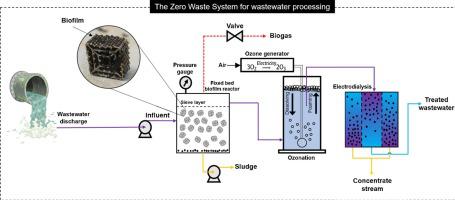Journal of Water Process Engineering ( IF 6.3 ) Pub Date : 2020-09-06 , DOI: 10.1016/j.jwpe.2020.101593 Sajjad Al-Amshawee , Mohd Yusri Bin Mohd Yunus , Rosli Bin Mohd Yunus , Joan G. Lynam

|
Wastewater processing mediates industrial and domestic wastes and supports societal, ecological, and economic values. Unfortunately, no single process alone is able to sustain wastewater processing. Thus, a Zero Waste System was devised combining fixed bed biofilm reactor (FBBR), ozonation, and electrodialysis to treat palm oil mill effluent (POME). The POME pollutants were biodegraded into smaller molecules inside the FBBR. This bioreactor was fully packed with Micro Media, Ultra Media, Kaldnes K1 micro, and green ammonia absorption stones. During the biodegradation, biogas and biomass were generated as valuable products. Ozonation oxidized all the FBBR effluents at an ozone dose of 15 mg/L for 24 h before being discharged for electrodialysis because bioremediation definitely does not decompose all suspended solids. Then, the electrodialysis received the ozonated effluents and electrically separated these biodegraded substances. The effluents of FBBR, ozonation, and electrodialysis were analyzed to find the chemical oxygen demand (COD), nitrogen ammonia (NH3–N), nitrite (NO2–), and nitrate (NO3––N) concentrations. The Zero Waste System involving Micro Media-FBBR, ozonation, and 40 volts electrodialysis successfully produced a first-class effluent that had 0 mg COD/L and 0 mg/L nitrogen compounds. In addition, it had a 0 mg/L concentration of K, Ca, Mg, Mn, Fe, B, Zn, Cu, Br2, Cl2, O3, and SO42–. So, the effluent would be expected to be appropriate for drinking, irrigation, discharging, and recycling purposes. This integrated process achieved excellent wastewater treatment and thus could improve the ecosystem.
中文翻译:

零废物系统,包括固定床生物膜反应器,臭氧氧化和电渗析脱盐,以实现废水可持续性
废水处理介导工业和家庭废物并支持社会,生态和经济价值。不幸的是,没有一个单独的过程能够维持废水处理。因此,设计了一种结合固定床生物膜反应器(FBBR),臭氧化和电渗析的零废物系统,以处理棕榈油厂的废水(POME)。POME污染物在FBBR内部被生物降解为较小的分子。该生物反应器装有Micro Media,Ultra Media,Kaldnes K1 micro和绿色氨吸收石。在生物降解过程中,沼气和生物质作为有价值的产物产生。臭氧化处理将所有FBBR流出物以15 mg / L的臭氧剂量氧化24小时,然后排出进行电渗析,因为生物修复绝对不能分解所有悬浮固体。然后,电渗析接受臭氧处理的废水,并电分离这些生物降解的物质。分析了FBBR,臭氧化和电渗析的废水以发现化学需氧量(COD),氨氮(NH3 –N),亚硝酸盐(NO 2 –)和硝酸盐(NO 3 ––N)浓度。涉及Micro Media-FBBR,臭氧化和40伏电渗析的零废物系统成功产生了一流的废水,其废水中的COD / L为0 mg / L,氮化合物为0 mg / L。此外,它有钾,钙,镁,锰,铁,硼,锌,铜,溴的0毫克/升的浓度2,氯2,O- 3,和SO 4 2-。因此,污水应适合饮用,灌溉,排放和循环再利用。该集成过程实现了出色的废水处理,因此可以改善生态系统。















































 京公网安备 11010802027423号
京公网安备 11010802027423号